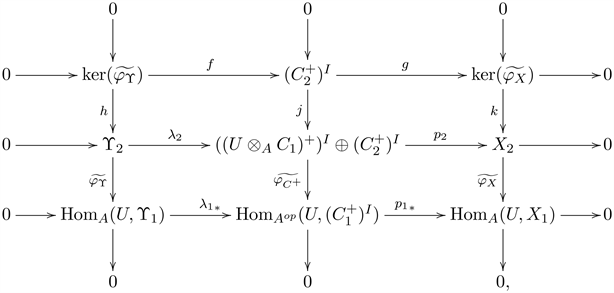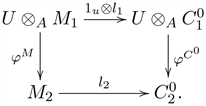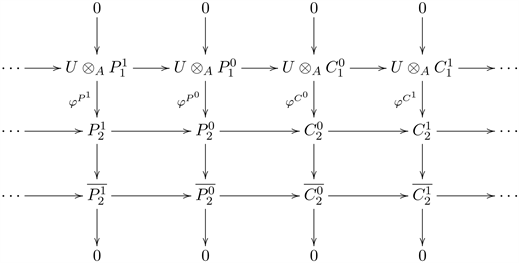Relative Ding Projective Modules over Formal Triangular Matrix Rings ()
1. Introduction
Let A and B be rings an U a
-bimodule,
is called a formal
triangular matrix ring with usual matrix addition and multiplication. This kind of ring is useful in the representation theory of algebras and ring theory. It is typically used to create examples and counterexamples, which add more examples and concreteness to the theory of rings and modules. Many authors have studied T in several directions. For example, Zhang [1] specifically described the Artin triangular matrix algebra with Gorenstein projective modules. Enochs, Izurdiaga and Torrecillas [2] characterized Gorenstein projective and injective modules over a triangular matrix ring. Mao [3] studied Gorenstein flat modules over T and provided a left global Gorenstein flat dimension estimate of T. Besides, he [4] studied cotorsion pairs and approximation classes over T.
This paper aims at investigating relative Ding projective modules and relative Ding projective dimension over T. Following is the organization of this paper.
In Section 2, we present some terminology as well as preliminary results.
In Section 3, we describe relative Ding projective modules over T. Assume that
and
are semidualizing. Let
,
and U be Ding C-compatible. Then a left T-module
is
-projective if and only if
is
-projective, Coker
is
-projective, and
is injective.
In Section 4, we estimate the
-projective dimension of a left T-module and the left global
-projective dimension of T. It is proved that, given a left T-module
, if
, U is Ding C-compatible,
and
are semidualizing, and
, then:
Consequently, we prove that,
So we establish a relationship between the relative Ding projective dimension of modules over T and modules over A and B.
All rings for this article are nonzero associative rings with identity, and all modules are unitary. Unless stated explicitly, all modules will serve as unital left R-modules. For a ring R, we write R-Mod (resp. Mod-R) for the category of left (resp. right) R-modules. For a left R-module C, we use AddR(C) (resp. addR(C)) to represent the class that contains all left R-modules that are isomorphic to direct summands of (resp. finite) direct sums of copies of C, and we use ProdR(C) to represent the class that contains all left R-modules that are isomorphic to direct summands of direct products of copies of C.
and
denote the classes of projective and flat left R-modules respectively. The character module
of a module M is signed by M+.
Next, we will review some concepts and facts about formal triangular matrix rings. By [ [5] , Theorem 1.5], T-Mod corresponds to the category Ω, whose objects are triples
, where
,
and
is a B-morphism and whose morphisms from
to
are pairs
such that
,
satisfying that the following diagram

is commutative. Given a triple
in Ω, there is an A-morphism
given by
for each
, and
.
It is worth noting that a sequence
of left T-modules is exact if and only if both the sequences
and
are exact.
Throughout this article,
is a formal triangular matrix ring. Given a left T-module
, the B-module Coker
is denoted as
and the A-module
is denoted as
.
Analogously, Mod-T is equivalent to the category Γ whose objects are triples
, where
,
and
is an A-morphism, and whose morphisms from
to
are pairs
such that
,
satisfying that the following diagram

is commutative.
Given such a triple
in Γ, there is the B-morphism
given by
for each
, and
.
In the remaining sections of the paper, we will identify T-Mod (resp. Mod-T) with the category Ω (resp. Γ)
According to [2] , the following functors exist between the category T-Mod and the product category
:
1)
is defined as follows: for each object (
) of
, let
with the obvious map and for any morphism (
) in
, let
.
2)
is defined as follows: for each object (
) of
, let
with the obvious map and for any morphism (
) in
, let
.
3)
is defined as follows: for each left T-module
as
, and for each morphism
in T-Mod as
.
Note that
is a left adjoint of
and
is a right adjoint of
. It is clear that
is exact.
, in particular, preserves projective objects, while
preserves injective objects.
Between the category Mod-T and the product category
, there are similar functors
.
Let
. By [6] ,
is the character right T-module of
, where
is defined by
for any
,
and
.
2. Preliminaries
Definition 2.1. ([ [7] , Definition 2.1]) A
-bimodule C is called semidualizing if the following conditions are satisfied:
1)
and
permit a degreewise finite projective resolution in the corresponding module categories.
2) The natural homothety morphisms
and
are ring isomorphisms.
3)
.
Definition 2.2. ([ [8] , Section 3]) A Wakamatsu tilting module is a left R-module
satisfying the following properties:
1)
permits a degreewise finite projective resolution.
2)
.
3) There exists a
-exact exact sequence of R-modules
where
for every
.
By [ [8] , Corollary 3.2],
is semidualizing if and only if
is a Wakamatsu tilting module with
if and only if
is a Wakamatsu tilting module with
.
Definition 2.3. ([ [9] , Definition 3.1]) Let
, M is said to be
-flat if
belongs to the class
, and we will denote the class of all
-flat modules as
.
When
,
. Thus
is a special case of
.
Remark 2.4. If
is semidualizing, then
by [ [9] , Proposition 3.3].
Lemma 2.5. ([ [10] , Lemma 4]) Let
and
.
if and only if
1)
;
2)
and
.
In this instance,
is injective.
Lemma 2.6. ([ [11] , Theorem 3.1]) Let
.
if and only if
,
and
is injective.
Lemma 2.7. Let
and
.
if and only if
1)
;
2)
and
.
In this instance,
is surjective.
Proof. “
” If
and
, then
and
for some
and some sets
and
. Without loss of generality, we can assume that
. Then:
Hence,
.
“
” Let
and
such that
for some set I. Then
is surjective as X is a submodule of
and
is surjective. Now, let
, there is an exact split sequence:
which induces the following commutative diagram with exact rows and columns:

where
are the canonical injections. Clearly,
and
are split epimorphisms. Thus,
. Next, we prove that the short exact sequence:
splits. Let r be the retraction of
. If
denotes the canonical injection by
, then
. Thus
and the first row is a split exact sequence too. So
and
.¨
Corollary 2.8. Let
and
.
If
, then
if and only if
1)
;
2)
and
.
In this instance,
is injective.
Proof.
if and only if
if and only if
,
,
by Lemma 2.7. Note that
is surjective. Hence,
is injective. Then we get an exact sequence
Consider the commutative diagram with exact rows shown below.

Thus
. So
if and only if
,
and
, and the proof is finished.
3. Relative Ding Projective Modules
This section will characterize relative Ding projective modules over a formal triangular matrix ring.
Definition 3.1 ([ [12] , Definition 1.1]) Let
be a semidualizing bimodule. A left R-module M is said to be
-projective if there exists a
-exact exact sequence in R-Mod:
with
,
for every
and
, such that
.
The class of all
-projective R-modules is denoted by
.
Note that if
, then
-projective R-modules are Ding projective R-modules.
We introduce the following concept, which is critical to the rest of this study, inspired by the definition of C-compatible bimodule in [ [10] , Definition 4].
Definition 3.2. Let
and
. A bimodule
is said to be Ding C-compatible if the following two conditions hold:
(a) The complex
is exact for every exact sequence in A-Mod:
with
and
for every
.
(b) The complex
is exact for every
-exact exact sequence in B-Mod:
with
and
for every
.
Furthermore, U is said to be weakly Ding C-compatible if it meets (b) and the following condition:
(a') The complex
is exact for every
-exact exact sequence in A-Mod:
with
and
for every
.
Proposition 3.3. Suppose that
be a left T-module and U be weakly Ding C-compatible. If
and
are semidualizing, then
is semidualizing.
Proof. Assume that
and
are semidualizing. By [ [8] , Corollary 3.2],
and
are tilting. To prove C is tilting, the functor
preserves finitely generated modules by [13] . Then
and
. Observe that
and
by [ [12] , Proposition 1.8]. Since U satisfies (a'),
. And, as U satisfies (b),
. For every
, by [ [10] , Lemma 3], we get that:
Furthermore, there exist exact sequences:
and:
which are
-exact and
-exact, respectively, and
,
,
. Note that every cokernel in
and
are finitely presented. Thus,
and
are exact. Since U is weakly Ding C-compatible, the complex
is exact. As a result, we get the following exaxt sequence
with
,
, by Lemma 2.5.
Let
, by Lemma 2.5,
where
and
. There is a complex isomorphism using adjointness (
):
It should be noted that the complexes
and
, as well as the complex
are exact since U is weakly Ding C-compatible. Then
is exact. So
is semidualizing by [ [8] , Corollary 3.2].¨
Lemma 3.4. Assume that
and
are semidualizing. Let
be a left T-module and U be weakly Ding C-compatible.
1) If
, then
.
2) If
, then
.
Proof. By Proposition 3.3, the functor
preservers semidualizing. Thus
by Remark 2.4.
1) Assume that
. There exists a
-exact exact sequence in A-Mod:
where
and
and
. Since U is weakly Ding C-compatible, we have the complex
is exact in B-Mod. So we get an exact sequence
with
Clearly,
and
for every
by Lemmas 2.6 and 2.5.
If
, then
by Corollary 2.8. Then using the adjointness, we get that
is exact. Thus
is
-projective.
2) Assume that
. There exists a
-exact exact sequence in B-Mod:
where
and
and
. As a result, we have an exact sequence
with
,
and
for every
by Lemmas 2.6 and 2.5 respectively. Let
, then
,
and
is injective by Corollary 2.8. Thus we obtain a short exact sequence:
Because U is weakly Ding C-compatible,
is a
-exact exact sequence. Then
. Consider a short exact sequence
with
is
-projective by [ [12] , Proposition 1.13]. Thus
, and then
. Consequently,
. Then we obtain the exact sequence of complexes shown below.
As U is weakly Ding C-compatible,
is exact and
is exact. Thus
is exact. Then
is exact. Above all,
.
Theorem 3.5. Assume that
and
are semidualizing. Let
,
and U be Ding C-compatible. Then the following statements are equivalent:
1) M is
-projective.
2)
is injective,
is
-projective and
is
-projective.
In this instance,
is
-projective if and only if
is
-projective.
Proof. (1)
(2) There exists a
-exact exact sequence in T-Mod:
where
and
, and such that
. Then we get an exact sequence in A-Mod:
where
and
by Lemmas 2.6 and 2.5 and such that
. As U is Ding C-compatible, the complex
is exact with
. Let
and
be the inclusions, then
is injective. Consequently, the commutative diagram is as follows:

According to Lemma 2.5,
is injective, then
will be as well. Furthermore, for every
,
and
are injective by Lemmas 2.5 and 2.6. The result is the commutative diagram with exact columns shown below.

Since the first and the second rows are exact in the above diagram, we get an exact sequence in B-Mod:
where
and
for every
by Lemmas 2.6 and 2.5, and such that
. Let
and
, then
and
by Corollary 2.8. Then by using adjointness,
is exact. Thus,
is
-projective. Note that
by Lemma 2.5. Then
by [ [10] , Lemma 3] and U is Ding C-compatible. As a result, when we apply the functor
to the sequence:
we get the exact sequence of complexes:
By applying adjointness, we obtain that
and
Note that
is exact, and since U is Ding C-compatible,
is exact too. It implies that
is exact. So
is
-projective.
2)
1) Because
is injective, an exact sequence exists in T-Mod:
By Theorem 3.5,
and
are
-projective T-modules. Hence, M is
-projective according to [ [12] , Theorem 1.12]. Finally, there exists an exact sequence
Since
is
-projective,
is
-projective if and only if
is
-projective by [ [12] , Theorem 2.12].
Corollary 3.6. Assume that
is semidualizing. Let R be a ring,
,
and
be a left
-module, then the following conditions are equivalent:
1) M is a
-projective left T(R)-module.
2)
and
is
-projective, and
is injective.
3)
and
is
-projective, and
is injective.
Proof. It is an immediate consequence of Theorem 3.5.¨
4. Relative Ding Projective Dimension
This section aims to search in the
-projective dimension of T-modules as well as the left
-projective global dimension of T. We now recall [12] that the concept of relative Ding projective dimenion. The
-projective dimension
-pd(M) of a left R-module M is defined as inf{n| there there is an exact sequence
with
for every
. The left global
-projective dimension of R is defined as:
.
Lemma 4.1. Assume that
and
are semidualizing. Let
and U Ding C-compatible. Then the following statements hold.
1)
.
2)
, and the equality is true if
.
Proof. 1) Consider the following exact sequence
with
is
-projective. As a result, we have an exact sequence in T-Mod:
with
-projective by Theorem 3.5. Furthermore, by Theorem 3.5,
is
-projective if and only if
is
-projective. This means that
if and only if
by [ [12] , Theorem 2.4].
2) We may assume that
. There exists an exact sequence in T-Mod:
with
. Then there is an exact sequence
with
by Theorem 3.5. Thus
.
In contrast, we demonstrate that
when
. We may assume that
. So there is an exact sequence
with
. As a result, the complex
is exact and each
is
-projective by [ [12] , Proposition 1.8], and then,
is
-projective by [ [12] , Theorem 2.4]. So there is an exact sequence
We obtain that
and all
are
-projective by Theorem 3.5. Thus we get
.
Inspired by the strong notion of the
-projective global dimension of B in [10] for estimating the
-projective dimension of a T-module and the left global
-projective dimension of T, we give the strong notion of the
-projective global dimension of B. Set:
.
Theorem 4.2. Assume that
and
are semidualizing. Let
and U Ding C-compatible. If
be a left T-module and
, then:
Proof. Let
. Firstly, we prove that
.
We may assume that
. Then there is an exact sequence
with
. Thus we achieve an exact sequence.
with
by Theorem 3.5. Thus,
.
Furthermore, according to Theorem 3.5, there is an exact sequence in B-Mod for each i
with
. Then
by [ [14] , Theorem 3.2]. There exists an exact sequence in B-Mod:
By [ [14] , Theorem 3.2],
.
Next, we prove that
. We may assume that:
,
and
. Since
, we have an exact sequence in A-Mod:
with
. There exists an epimorphism
with
by [ [12] , Proposition 1.8]. Let
and define the map
to be
. Then we get an exact sequence
In a similar way, there exists an exact sequence of B-modules
with
. So we obtain an exact sequence
Repeating this process, we obtain an exact sequence
Note that
,
. By [ [14] , Theorem 3.2], the exact sequence
gives that
. As a result, we have an exact sequence in B-Mod
which induces an exact sequence in T-Mod:
Since all
and
are
-projective by Theorem 3.5,
.¨
Corollary 4.3. Assume that
and
are semidualizing. Let
and U Ding C-compatible. If
, then
if and only if
and
.
Theorem 4.4. Assume that
and
are semidualizing. Let
and U Ding C-compatible. Then
Proof. Firstly, we show that the left side of the inequality. Assume that
. Let
and
. Because
and
,
and
by Lemma 4.1. Consequently,
and
.
Secondly, we show that the right side of the inequality. Assume that:
.
Then
and
. Let
be a left T-module. According to Theorem 4.2,
.
Corollary 4.5. Assume that
and
are semidualizing. Let
and U Ding C-compatible. Then
if and only if
and
.
Corollary 4.6. Assume that
is semidualizing. Let
and
. Then
.
Proof. We know that R is Ding C-compatible and
. Therefore by Theorem 4.4,
.
It is obvious in the case
. We may assume that
. Then there exists a left R-module M with
and
for some
by [ [12] , Theorem 2.4]. Now we consider an exact sequence in
-Mod:
By applying the long exact sequence theorem to the preceding exact sequence, we obtain that
By [ [10] , Lemma 3], we know that
.
Thus by [ [10] , Lemma 3] and the above exact sequence,
As
by Corollary 2.8, we have
by [ [12] , Theorem 2.4]. Besides,
. Thus
, which implies that
.¨
Acknowledgements
This research was partially supported by NSFC (Grant No. 12061026), and NSF of Guangxi Province of China (Grant No. 2020GXNSFAA159120).
The authors thank the referee for the useful suggestions.